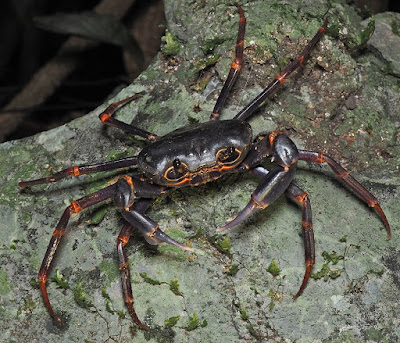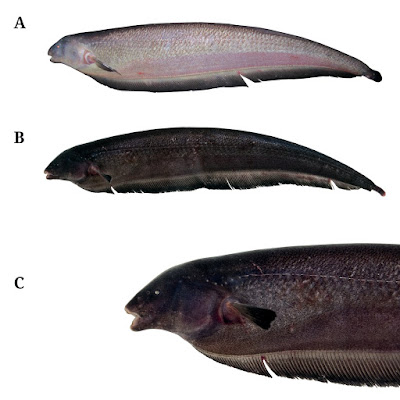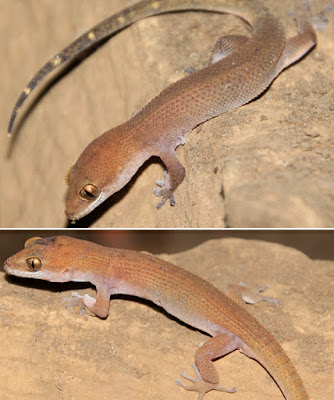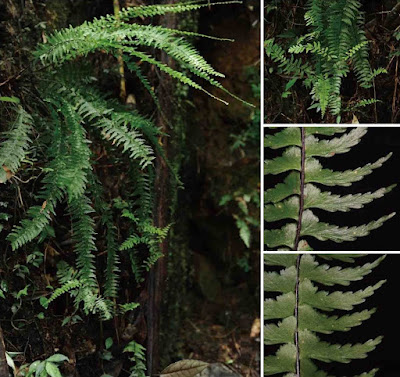[Most Recent Entries] [Calendar View]
Tuesday, April 21st, 2020
| Time | Event | ||||||
| 11:30a | [Crustacea • 2020] Calcipotamon puglabrum • A New Long-legged Terrestrial Freshwater Crab (Decapoda: Potamidae) from Hainan Island, China
Abstract A new genus and new species of terrestrial freshwater crab, Calcipotamon puglabrum gen. nov. et sp. nov., is described from the limestone forests of Changjiang, Hainan Island, China, based on morphology and mitochondrial 16S rDNA sequences. The new genus is closest to Neotiwaripotamon Dai & Naiyanetr, 1994, and Tiwaripotamon Bott, 1970, but differs in a combination of carapace, third maxilliped, ambulatory leg and male gonopod characters. Molecular analysis shows that the new genus is closely related with but not clustered within other Hainan potamid genera. Notes on the general biology of this new species are also provided. Keywords: Crustacea, freshwater crab, Hainan, new genus, new species, Potamidae, systematics Calcipotamon puglabrum gen. nov. et sp. nov. Chao Huang, Sheng-Zhuo Huang and Zhi-Xin Shen. 2020. A New Long-legged Terrestrial Freshwater Crab, Calcipotamon puglabrum gen. nov. et sp. nov. (Crustacea: Decapoda: Potamidae), from Hainan Island, China. Zootaxa. 4766(3); 447–456. DOI: 10.11646/zootaxa.4766.3.4 | ||||||
| 12:08p | [Ichthyology • 2020] Tenebrosternarchus preto • A Redescription of Deep-channel Ghost Knifefish, Sternarchogiton preto (Gymnotiformes: Apteronotidae), with Assignment to A New Genus
ABSTRACT From a study of morphological and molecular datasets we determine that a species originally described as Sternarchogiton preto does not form a monophyletic group with the other valid species of Sternarchogiton including the type species, S. nattereri. Previously-published phylogenetic analyses indicate that this species is sister to a diverse clade comprised of six described apteronotid genera. We therefore place it into a new genus diagnosed by the presence of three cranial fontanels, first and second infraorbital bones independent (not fused), the absence of an ascending process on the endopterygoid, and dark brown to black pigments over the body surface and fins membranes. We additionally provide a redescription of this enigmatic species with an emphasis on its osteology, and provide the first documentation of secondary sexual dimorphism in this species. Keywords: Amazonia; Neotropics; Sexual dimorphism; Systematics; Taxonomy Tenebrosternarchus, new genus Type species. Sternarchogiton preto Santana, Crampton, 2007, by monotypy. Diagnosis. Tenebrosternarchus is diagnosed from all other apteronotid genera by the following unique combination of four characters: three cranial fontanels present (vs. two in other apteronotids), bones 1 and 2 of the infraorbital laterosensory canal present as independently ossified tubes (vs. fused into a single bony element), ascending process of endopterygoid absent (vs. present), and brown to purplish-black pigment present over the dorsum, sides and fins (vs. absent or restricted to dorsum and distal fin margins). For field identification, this genus may be reliably distinguished from all other members of the Navajini by the combination of uniform dark coloration, the presence of five or more teeth on the premaxilla at all life stages, and gape not exceeding a vertical with eye. Etymology. Tenebro from the Latin tenebrae meaning darkness in reference to the black pigmentation of this genus, and the Greek sternarchus (sternon and archos), a common generic suffix applied to apteronotids referring to the anterior position of the anus common to all Gymnotiformes. Tenebrosternarchus preto (Santana, Crampton, 2007), new comb. Sternarchogiton preto de Santana, Crampton, 2007: fig. 5 table 1 (original description). -Crampton, 2007: 287, 291, 317, table 11.1, 11.2. -Crampton, 2011: 178, table 10.2. -Crampton, Cella-Ribeiro, 2013: 282-283 (photograph). -Silva et al., 2014: 638-645, fig. 2. -Tagliacollo et al., 2016: 30, fig. 6 (misidentification). -Smith et al., 2016: 306-309, fig. 2. -Ferraris, Vari, de Santana, 2017: 12. - Bernt et al., 2018: 466, 471, 474-477, table 2. - Bernt et al., 2019: 299-302, figs. 3, 4, 6. -Evans et al., 2019: 424-425, figs. 2, 3. Sternarchogiton porcinum Cox-Fernandes, 1995: 32-33, figs. 2-38, 2-39. -Crampton, 1996: fig. 6.1. -Crampton, 1998a: 817, 821, 830, 832, tables 3, 4, 5, 6. -Crampton, 1998b: 315, table 2. Diagnosis: External morphology. Body shape and pigmentation illustrated in Fig. 1. Summary of morphometric data and meristics shown in Tab. 1. Largest recorded size 330 mm TL. Body elongate and laterally compressed. Body depth greater than head depth. Forehead convex, sloped at approximately 45° in most specimens. Gape extending to or beyond vertical with posterior nares, but not reaching vertical with eye. Mouth subterminal. Eye diameter small, less than 10% head length, covered by thin layer of skin. Scales on body large and rhomboid forming 3-5 rows above lateral line at midbody. Scales absent on entire middorsum and over nape above lateral line to 5th lateral-line pore. Fleshy midsagittal electroreceptive organ originating on posterior third of dorsum. Nasal capsule closer to eye than to snout tip. Anterior nares tubular.
Ecology. Little is presently known about the ecology of Tenebrosternarchus. Typically among ghost knifefishes, species inhabiting deep river channels (sensu Crampton, 2007) have greatly reduced pigmentation, often appearing pink or white (e.g., Orthosternarchus Ellis, 1912, Sternarchella Eigenmann, 1905), while those inhabiting smaller streams or marginal habitats of larger rivers have much darker coloration (e.g., Apteronotus Lacepède, 1800, Platyurosternarchus Mago-Leccia, 1994). Interestingly, T. preto, with its dark coloration, appears to be an obligate channel-dweller, and does not appear to frequent shallower waters more than other members of the Navajini. This genus does seem to have a habitat preference for low-conductivity blackwater rivers as a majority of specimens we examined were collected from the rio Negro and the río Nanay (both blackwater rivers). This preference for blackwater does not appear to be as strict as that of Melanosternarchus (see Bernt et al., 2018), as specimens of T. preto are also collected from whitewater channels (e.g., the Amazon, Apure, and Madeira rivers). Specimens are also known from near the mouths of clearwater rivers (Tapajós and Xingu), but they are not known to be more abundant in these rivers than in whitewaters. Nearly all specimens from whitewater rivers have regenerated caudal fins (a common condition among apteronotids), while undamaged tails are more common from blackwater with about 70% of specimens showing signs of regeneration. Tenebrosternarchus is typically found among aggregations of other channel knifefishes, especially Rhabdolichops Eigenmann, Allen, 1942, Sternarchella, Orthosternarchus Ellis, 1912, and Sternarchorhamphus Eigenmann, 1905. It tends to be relatively uncommon in trawl samples, but was found to be locally abundant on the río Nanay in the vicinity of Iquitos, Peru during low water (June-August). Notably, specimens collected at this time and place were found to be substantially larger in average size (250-300 mm) than those from other collections. Examination of gut contents of several specimens from this habitat revealed that T. preto feeds most heavily on chironomid larvae, though coleopteran and ceratopogonid larvae were also present. These larvae were found to be mixed with sand and detritus, suggesting that T. preto is a primarily a benthic forager. Crampton (2007) also reports that this species feeds on freshwater sponges of the genus Drulia. Distribution. The collection localities of samples analyzed in this study are summarized in Fig. 12. Our examined material of Tenebrosternarchus ranges from the western Amazon at Iquitos, Peru to the mouth of the rio Xingu in Pará, Brazil, the rio Negro, from Manaus to Barcelos, and the Orinoco Basin in Venezuela, from the río Apure at San Fernando de Apure to near the mouth of the río Orinoco in Delta Amacuro. Crampton, Cella-Ribeiro (2013) also report this species from the Madeira drainage above the extensive system of cataracts beginning at Porto Velho.
Maxwell J. Bernt, Aaron H. Fronk, Kory M. Evans and James S. Albert. 2020. A Redescription of Deep-channel Ghost Knifefish, Sternarchogiton preto (Gymnotiformes: Apteronotidae), with Assignment to A New Genus. Neotropical Ichthyology. 18(1). DOI: 10.1590/1982-0224-2019-0126 RESUMO: Através de um estudo com dados morfológicos e moleculares, nós propomos que a espécie originalmente descrita como Sternarchogiton preto não forma um grupo monofilético com outras espécies válidas de Sternarchogiton incluindo a espécie-tipo, S. nattereri. Análises filogenéticas anteriormente publicadas indicam que essa espécie é irmã de um clado diverso contendo seis gêneros descritos de Apteronotidae. Nós então a alocamos em um novo gênero diagnosticado pela presença de três fontanelas craniais, primeiro e segundo ossos infraorbitais independentes (não fusionados), ausência de um processo ascendente do endopterigoide e pigmentação marrom-escura à negra sobre a superfície do corpo e membranas das nadadeiras. Adicionalmente, nós realizamos a redescrição dessa enigmática espécie com ênfase na sua osteologia, e fazemos o primeiro registro de dimorfismo sexual secundário nessa espécie. Palavras-chave: Amazônia; Dimorfismo Sexual; Neotrópico; Sistemática; Taxonomia | ||||||
| 12:12p | [Herpetology • 2020] Dixonius lao • A New Species of Dixonius (Squamata: Gekkonidae) from the Karst Forest of Khammouane Province, central Laos
Abstract A new species of Dixonius is described on the basis of three specimens from the karst forests around Thakhek town, Khammouane Province, Laos. The new species from Laos can be distinguished from other species of Dixonius based on molecular and morphological divergences. It is characterized by a maximum SVL of 55.4 mm; 20–23 longitudinal rows of dorsal tubercles at mid-body; 23–24 longitudinal rows of ventrals across the abdomen; 8–10 supralabials, 7 or 8 in mid-orbital position; 7 or 8 infralabials; 8 precloacal pores in male; the male without femoral pores; precloacal and femoral pores absent in females; uniformly pebble brown dorsum. In phylogenetic analyses, the new species is shown to be the sister taxon to two undescribed taxa from Thailand but differs by at least 8.6% in genetic pairwise distance from the latter based on the complete sequences of the mitochondrial ND2 gene with partial or complete sequences of six adjacent tRNAs. This is the ninth known species of Dixonius, and the second recorded species from Laos. Keywords: Reptilia, Dixonius lao sp. nov., Khammouane Province, morphology, phylogeny, taxonomy
Dixonius lao sp. nov. Thuong H. Nguyen, Saly Sitthivong, Hanh T. Ngo, Vinh Q. Luu, Quang T. Nguyen, Minh D. Le and Thomas Ziegler. 2020. A New Species of Dixonius (Squamata: Gekkonidae) from the Karst Forest of Khammouane Province, central Laos. Zootaxa. 4759(4); 530–542. DOI: 10.11646/zootaxa.4759.4.4 | ||||||
| 11:57p | [Botany • 2020] Asplenium normale f. scythiforme (Aspleniaceae) • New Addition to the Asplenium normale complex: An Endemic forma in Taiwan
Abstract Evolutionary histories of species complexes in ferns are usually complicated with hybridization and polyploidization. In the Asplenium normale D.Don complex, we here identify a new taxon - Asplenium normale f. scythiforme Z.X. Chang, f. nov., by clarifying its position in the reticulated tree of the species complex. Our phylogenetic and flow cytometric results surprisingly support that this new taxon is a non-hybridized diploid and conspecific with A. normale. Nonetheless, the forma scythiforme can be separated from the normale by having more dissected and falcate pinnae with apices acuminate to fishbone-like tails. Currently, A. normale f. scythiforme was found to be endemic to Taiwan with only one northern and one southern populations. Keyword: Asplenium normale f. scythiforme, Asplenium normale complex, flow cytometry, morphology, phylogenetic Asplenium normale f. scythiforme Z.X. Chang, f. nov. 鐮羽鐵角蕨 Distribution: This forma is currently known with only two small populations that grow in Chamaecyparis montane mixed cloud forest and Pasania–Elaeocarpus montane evergreen broad-leaved cloud forest (Li et al., 2013) in northern and southern Taiwan respectively, and coexists with Asplenium normale f. normale. We speculate that the local populations have propagated asexually with vegetative buds. Etymology: The ‘‘scythiforme’’ means the pinnae shape like the scythe, which was used to mow the grass. Note: Since 2007, we have never seen any individuals that producing fertile leaves in wild as well as three-year planted individuals in the Dr. Cecilia Koo Botanic Conservation Center (KBCC). Zhi-Xiang Chang, Li-Yaung Kuo, Pi-Fong Lu and Yao-Moan Huang. 2020. New Addition to the Asplenium normale complex (Aspleniaceae): An Endemic forma in Taiwan. Taiwania. 65(2); .253-260. |
| << Previous Day |
2020/04/21 [Calendar] |
Next Day >> |













